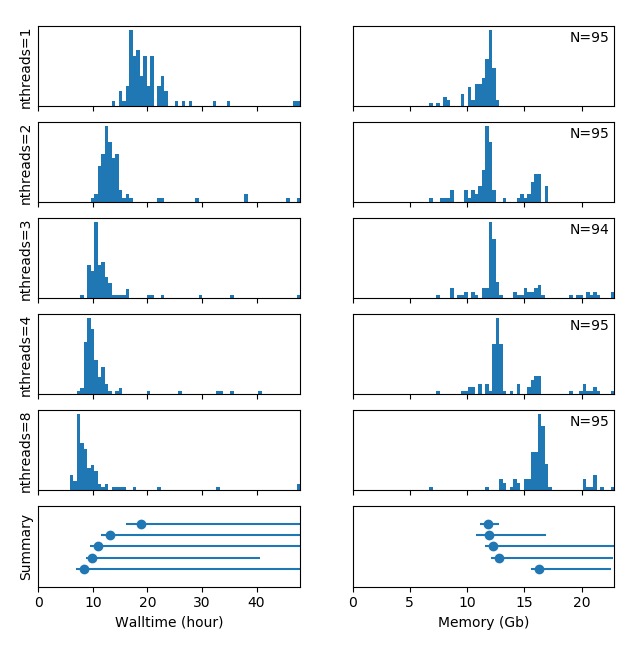Utilities for using fmriprep on the compute cluster at the Donders Institute of the Radboud University.
The fmriprep_sub.py utility is a wrapper around fmriprep that queries the BIDS directory for new participants and then runs them (as single-participant fmriprep jobs) on the compute cluster. For more info run: $ fmriprep_sub.py -h
$ fmriprep_sub.py /project/3017065.01/bids --nthreads 3 --mem_mb 28000
>>> Submitting job (1/95):
qsub -l nodes=1:ppn=3,walltime=48:00:00,mem=28000mb,file=50gb -N fmriprep_sub-P004 <<EOF
cd /home/mrphys/marzwi
unset PYTHONPATH; export PYTHONNOUSERSITE=1; singularity run --cleanenv /opt/fmriprep/20.2.1/fmriprep-20.2.1.simg /project/3017065.01/bids /project/3017065.01/bids/derivatives participant -w \$TMPDIR --participant-label P004 --skip-bids-validation --fs-license-file /opt_host/fmriprep/license.txt --mem_mb 28000 --omp-nthreads 3 --nthreads 3
EOF
>>> Skipping already running / scheduled job (2/95): fmriprep_sub-P001
>>> Nothing to do for job (3/95): /project/3017065.01/bids/sub-P003 (--> /project/3017065.01/bids/derivatives/fmriprep/sub-P003.html)
>>> Submitting job (4/95):
qsub -l nodes=1:ppn=3,walltime=48:00:00,mem=28000mb,file=50gb -N fmriprep_sub-P002 <<EOF
cd /home/mrphys/marzwi
unset PYTHONPATH; export PYTHONNOUSERSITE=1; singularity run --cleanenv /opt/fmriprep/20.2.1/fmriprep-20.2.1.simg /project/3017065.01/bids /project/3017065.01/bids/derivatives participant -w \$TMPDIR --participant-label P002 --skip-bids-validation --fs-license-file /opt_host/fmriprep/license.txt --mem_mb 28000 --omp-nthreads 3 --nthreads 3
EOF
>>> Submitting job (5/95):
[..]
>>> Submitting job (95/95):
qsub -l nodes=1:ppn=3,walltime=48:00:00,mem=28000mb,file=50gb -N fmriprep_sub-P295 <<EOF
cd /home/mrphys/marzwi
unset PYTHONPATH; export PYTHONNOUSERSITE=1; singularity run --cleanenv /opt/fmriprep/20.2.1/fmriprep-20.2.1.simg /project/3017065.01/bids /project/3017065.01/bids/derivatives participant -w \$TMPDIR --participant-label P295 --skip-bids-validation --fs-license-file /opt_host/fmriprep/license.txt --mem_mb 28000 --omp-nthreads 3 --nthreads 3
EOF
----------------
Done! Now wait for the jobs to finish... Check that e.g. with this command:
qstat -a $(qselect -s RQ) | grep fmriprep_sub
You can check how much memory and walltime your jobs have used by running:
hpc_resource_usage.pyThe hpc_resource_usage.py utility plots walltime and memory usage of PBS jobs submitted to the compute cluster. For more info run: $ hpc_resource_usage.py -h
The PBS logfiles of the fmriprep_sub.py command as shown above with 1, 2, 3, 4 and 8 compute threads & CPU cores were saved in separate directories. This multi-threading benchmark dataset is loaded as example data when running the demo:
$ hpc_resource_usage.py -s demo
Reading logfiles from: "/opt/fmriprep/dccn/nthreads=1/fmriprep_sub-*.o*"
Reading logfiles from: "/opt/fmriprep/dccn/nthreads=2/fmriprep_sub-*.o*"
Reading logfiles from: "/opt/fmriprep/dccn/nthreads=3/fmriprep_sub-*.o*"
Reading logfiles from: "/opt/fmriprep/dccn/nthreads=4/fmriprep_sub-*.o*"
Reading logfiles from: "/opt/fmriprep/dccn/nthreads=8/fmriprep_sub-*.o*"- Conclusions on fmriprep v20.2.1 multi-threading:
- The speed increase is not very significant when increasing the number of compute threads above 3
- The majority of jobs of the same batch require a comparable walltime, but a few jobs take much longer. NB: The spread of the distributions is increased by the heterogeneity of the DCCN compute cluster and occasional inconsistencies (repeats) in the data acquisition in certain (heavily moving) participants
- The memory usage of the majority of all jobs is comparable and largely independen of the number of threads, but distinct higher peaks in the distribution appear with an increasing number of threads
